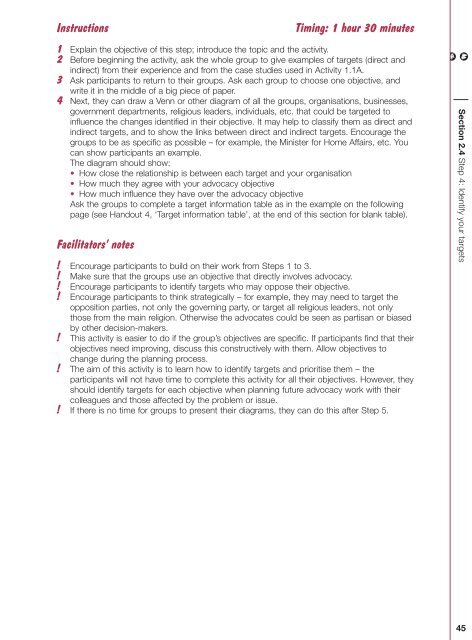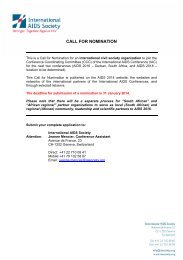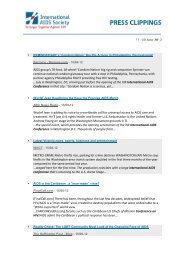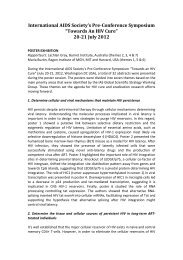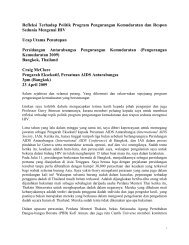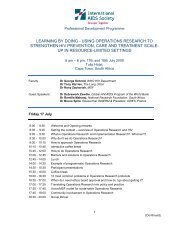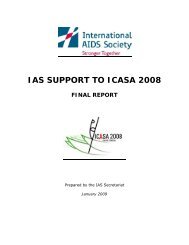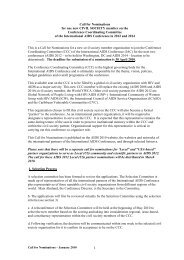Advocacy in Action - International AIDS Society
Advocacy in Action - International AIDS Society
Advocacy in Action - International AIDS Society
You also want an ePaper? Increase the reach of your titles
YUMPU automatically turns print PDFs into web optimized ePapers that Google loves.
Instructions<br />
Tim<strong>in</strong>g: 1 hour 30 m<strong>in</strong>utes<br />
1 Expla<strong>in</strong> the objective of this step; <strong>in</strong>troduce the topic and the activity.<br />
2 Before beg<strong>in</strong>n<strong>in</strong>g the activity, ask the whole group to give examples of targets (direct and<br />
<strong>in</strong>direct) from their experience and from the case studies used <strong>in</strong> Activity 1.1A.<br />
3 Ask participants to return to their groups. Ask each group to choose one objective, and<br />
write it <strong>in</strong> the middle of a big piece of paper.<br />
4 Next, they can draw a Venn or other diagram of all the groups, organisations, bus<strong>in</strong>esses,<br />
government departments, religious leaders, <strong>in</strong>dividuals, etc. that could be targeted to<br />
<strong>in</strong>fluence the changes identified <strong>in</strong> their objective. It may help to classify them as direct and<br />
<strong>in</strong>direct targets, and to show the l<strong>in</strong>ks between direct and <strong>in</strong>direct targets. Encourage the<br />
groups to be as specific as possible – for example, the M<strong>in</strong>ister for Home Affairs, etc. You<br />
can show participants an example.<br />
The diagram should show:<br />
• How close the relationship is between each target and your organisation<br />
• How much they agree with your advocacy objective<br />
• How much <strong>in</strong>fluence they have over the advocacy objective<br />
Ask the groups to complete a target <strong>in</strong>formation table as <strong>in</strong> the example on the follow<strong>in</strong>g<br />
page (see Handout 4, ‘Target <strong>in</strong>formation table’, at the end of this section for blank table).<br />
Facilitators’ notes<br />
! Encourage participants to build on their work from Steps 1 to 3.<br />
! Make sure that the groups use an objective that directly <strong>in</strong>volves advocacy.<br />
! Encourage participants to identify targets who may oppose their objective.<br />
! Encourage participants to th<strong>in</strong>k strategically – for example, they may need to target the<br />
opposition parties, not only the govern<strong>in</strong>g party, or target all religious leaders, not only<br />
those from the ma<strong>in</strong> religion. Otherwise the advocates could be seen as partisan or biased<br />
by other decision-makers.<br />
! This activity is easier to do if the group’s objectives are specific. If participants f<strong>in</strong>d that their<br />
objectives need improv<strong>in</strong>g, discuss this constructively with them. Allow objectives to<br />
change dur<strong>in</strong>g the plann<strong>in</strong>g process.<br />
! The aim of this activity is to learn how to identify targets and prioritise them – the<br />
participants will not have time to complete this activity for all their objectives. However, they<br />
should identify targets for each objective when plann<strong>in</strong>g future advocacy work with their<br />
colleagues and those affected by the problem or issue.<br />
! If there is no time for groups to present their diagrams, they can do this after Step 5.<br />
Section 2.4 Step 4: Identify your targets<br />
45


